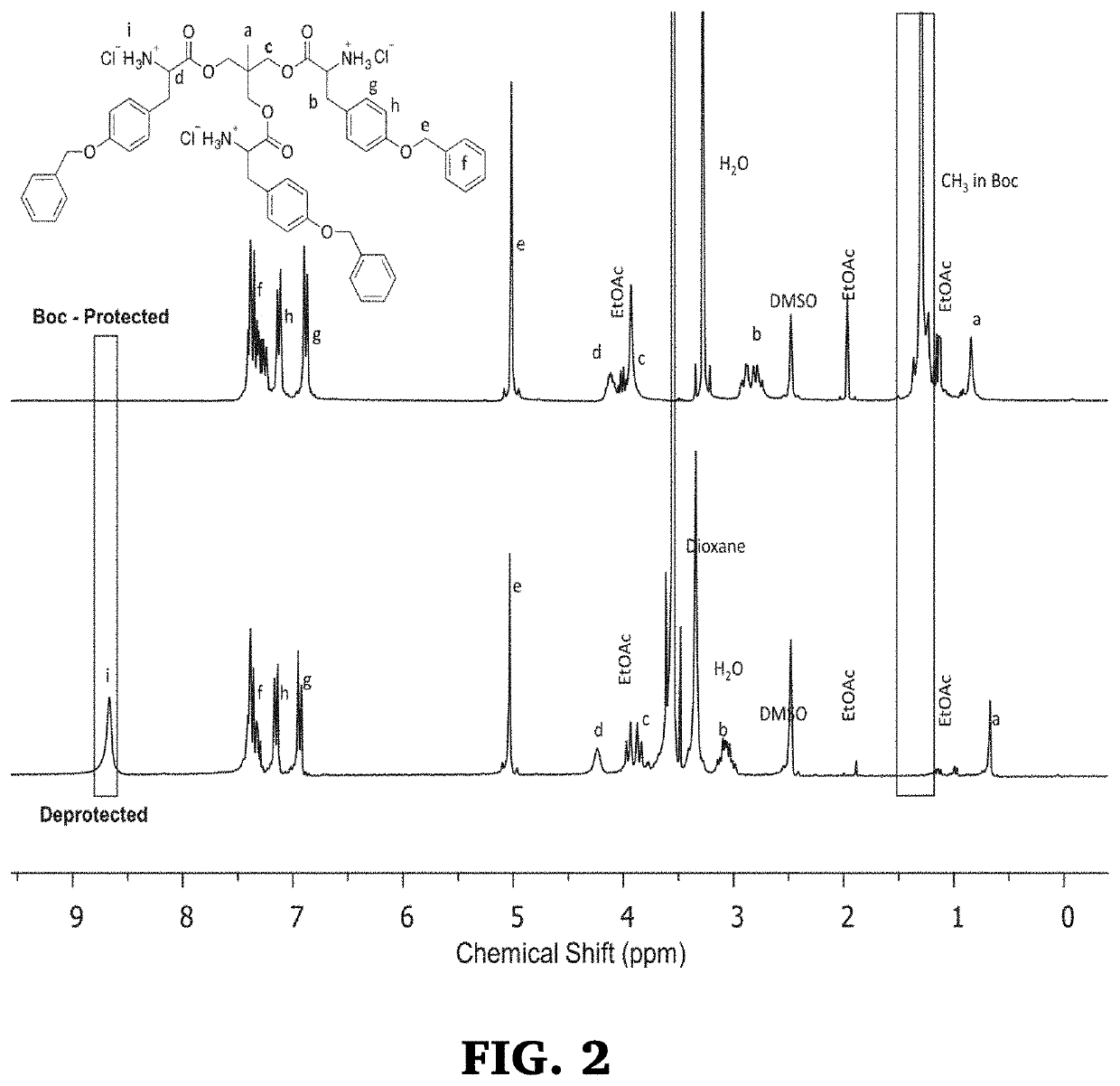Amino acid-based poly(ester urea) polymer mesh for hernia and other soft tissue applications
- Summary
- Abstract
- Description
- Claims
- Application Information
AI Technical Summary
Benefits of technology
Problems solved by technology
Method used
Image
Examples
example 1
Synthesis of Di-p-toluenesulfonic Acid Salts of Bis(L-valine)-Octane 1, 8-Diester Monomer (1-VAL-8)
[0190]Synthesis of di-p-toluenesulfonic acid salts of bis(L-valine)-octane 1,8-diester (1-VAL-8) was carried out following previously published procedures. See, Yu, J.; Lin, F.; Lin, P.; Gao, Y.; Becker, M. L. “Phenylalanine-based poly(ester urea): Synthesis, characterization, and in vitro degradation.”Macromolecules 2014 DOI: 10.1021 / ma401752b, the disclosure of which is incorporated herein by reference. Briefly, 1,8-octanediol (43.8 g, 0.3 mol, 1 eq.), L-valine (73.8 g, 0.63 mol, 2.3 eq.), p-toluenesulfonic acid monohydrate (131.3 g, 0.69 mol, 2.4 eq.), and toluene (1300 mL) were added to a 3 L 3-neck round bottom flask and mixed with overhead mechanical stirring. A Dean-Stark Trap was attached to the round bottom flask and the reaction was heated to reflux for 24 h. The reaction was cooled to ambient temperature, and the resulting white precipitate was isolated by vacuum filtration ...
example 2
Synthesis of Di-p-toluenesulfonic Acid Salts of Bis(L-valine)-Decane 1,10-Diester Monomer. (1-VAL-10)
[0191]Synthesis of di-p-toluenesulfonic acid salts of bis(L-valine)-decane 1,10-diester (1-VAL-10) was carried out using the method described I Example 1, above except that 1,10-decanediol was used in place of 1,8-octanediol (154 g, 71% yield). 1H NMR (300 MHz, DMSO-d6): δ=0.93-1.00 (m, 12H, —CH(CH3)2—), 1.22-1.33 (s, 12H, —COOCH2CH2(CH2)6—), 1.55-1.64 (m, 4H, —COOCH2CH2(CH2)4CH2—), 2.09-2.21 (m, 2H, (CH3)2CH—), 2.28-2.31 (s, 6H, —CH3Ar—), 2.50 (m, DMSO), 3.30-3.35 (s, H2O), 3.87-3.91 (d, J=4.5 Hz, 2H, +NH3CHCOO—), 4.08-4.24 (m, 4H, —COOCH2CH2(CH2)6—), 7.10-7.13 (d, J=7.8 Hz, 4H, aromatic H), 7.47-7.51 (d, J=7.8 Hz, 4H, aromatic H), 8.27-8.31 (br, 6H, —NH3+). (See, FIG. 1)
example 3
Synthesis of Di-p-toluenesulfonic Acid Salts of Bis-(l-valine)-Dodecane 1,12-Diester Monomer. (1-VAL-12)
[0192]Synthesis of di-p-toluenesulfonic acid salts of bis(L-valine)-dodecane 1,12-diester (1-VAL-12) was carried out using the method described above (106 g, 82% yield). 1H NMR (300 MHz, DMSO-d6): δ=0.90-0.98 (m, 12H, —CH(CH3)2), 1.22-1.27 (s, 16H, —COOCH2CH2(CH2)8—), 1.53-1.63 (m, 4H, —COOCH2CH2(CH2)8CH2—), 2.07-2.18 (m, 2H, (CH3)2CH+—), 2.27-2.29 (s, 6H, —CH3Ar—), 2.50 (m, DMSO), 3.29-3.33 (s, H2O), 3.87-3.90 (d, J=4.3 Hz, 2H, +NH3CHCOO—), 4.06-4.22 (m, 4H, —COOCH2CH2(CH2)8—), 7.08-7.11 (d, J=7.9 Hz, 4H, aromatic H), 7.45-7.49 (d, J=8.1 Hz, 4H, aromatic H), 8.25-8.28 (br, 6H, —NH3+). (See, FIG. 1)
PUM
| Property | Measurement | Unit |
|---|---|---|
| Length | aaaaa | aaaaa |
| Length | aaaaa | aaaaa |
| Time | aaaaa | aaaaa |
Abstract
Description
Claims
Application Information
 Login to View More
Login to View More - R&D
- Intellectual Property
- Life Sciences
- Materials
- Tech Scout
- Unparalleled Data Quality
- Higher Quality Content
- 60% Fewer Hallucinations
Browse by: Latest US Patents, China's latest patents, Technical Efficacy Thesaurus, Application Domain, Technology Topic, Popular Technical Reports.
© 2025 PatSnap. All rights reserved.Legal|Privacy policy|Modern Slavery Act Transparency Statement|Sitemap|About US| Contact US: help@patsnap.com



